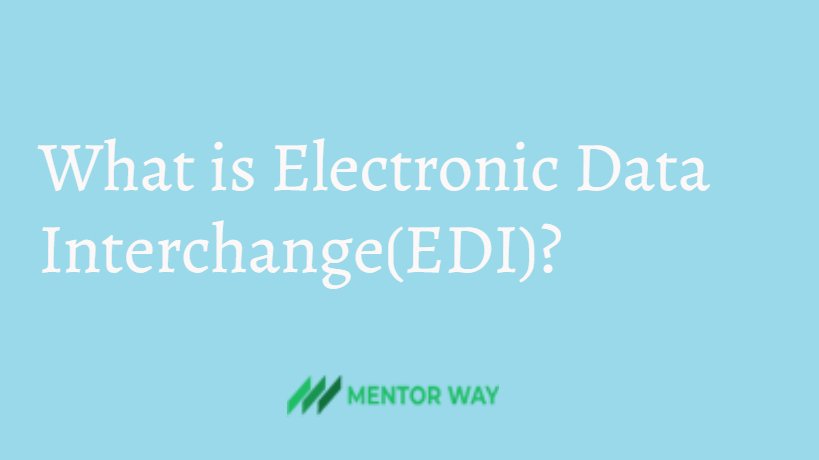What is Electronic Data Interchange(EDI)?
4 min read
Electronic data interchange (EDI) Is the electronic exchange of business documents in standard, computer-processable, universally accepted format between the business partners.
EDI may be defined as the transmission of business data in a structured, electronic format from a computer application in one business format from a computer application in one business to a computer application in another.
The transfer can be done through a direct computer link or through a modem in telecommunication network. EDI is a communication between applications, it can occur between computers if each of them can accept identical data formats.
According to International Data Exchange Association (IDEA), EDI is defined as “ The transfer of structured data, by agreed message standards, from one computer system to another, by electronic means. “ This definition of EDI has four elements, all of which are essential to an EDI system:
-
Structured Data:-
EDI transactions are composed of codes, values, short pieces of text. Each element has a strictly defined purpose. For example, an order has codes for the customer, product, quantity ordered etc.
-
Agreed Message Standards:
The EDI transaction has to have a standard format. The standard is a not just agreed between the trading partners but is a general standard agreed at a national or international level.
-
From one Computer System To Another:
The EDI message sent is between two computer applications. There is no requirement for people to read the message or re-key it into a computer system.
-
By Electronic Means:
The EDI message id dent electronically i.e. by using networks specifically designed for EDI.
EDI allows one computer system to communicate with another computer system using a standardardized electronic form. EDI is the computer-to-computer exchange of business data in standard formats.
Earlier, companies used paper medium for conducting business. They used to enter to enter data into a business application, print the form containing data, and mail this form to a trading partner.
The exchange of information between companies relied heavily on the postal system, The trading partner, after receiving the from used to rekey the data into another business application.
This process had may drawbacks such as poor response time, excessive paper-work for both the companies, more chances of errors, low accuracy, increased uncertainty, high labour charges etc.
The advent of business computer has enabled companies to process data electronically, i.e. exchanging information via electronic means. These problems have been significantly reduced through the use of EDI as it automates the exchange of document between two partners communicating with each other.
The information produced by the source computer in a organization is converted into an EDI format by translation software and is sent to the receiving computer over a digital network. On the receiving side, the translation software converts the EDI format into the form required by the business application at that end.
An EDI system gets data from an application and translates them into one of the flexible formats defined by system and sent according to the agreed communication method. The receiver can interpret the message and translate it into the format which is used by his own system.
EDI systems are very different from the data communication systems, which cause only transmission of data without further actions from the computer system. They are different from e-mail which must be read by the receiver and which does not make use of standardized document formats.
There is no agreement needed between the sender and the receiver relating to the way of processing the mail. In case of EDI, the co-ordination of the format and the contents of data are necessary. Each element of data is standardized. The computer which receives the data can understand it automatically.
In EDI, the computer applications of both the sender and the receiver, referred to as Trading Partners, have to agree upon a common format of the business document which is being sent as a data file over the communications channel, allowing a transaction that requires no human intervention at either end. All information contained in an EDI transaction set is the same as on a conventionally printed document.
The two key features of EDI include the electronic exchange of information, and standard formats or business forms. The electronic exchange of information requires the presence of direct or indirect interconnection between the involved partners.
The typical business forms used is EDI include schedules, purchase orders, acknowledgements, delivery related documentations, receipt notes, invoices, payments through electronic funds transfer, manifests and many other forms depending upon the application area.
These documents have to follow a standard format. The standardization of format helps in exchanging these documents between trading partners who may have heterogeneous computing environments.
The EDI transaction for a purchase, shipment and corresponding payment are as follow:
Step 1: Buyer’s computer sends a Request For Quotation to the seller’s computer.
Step 2: Seller’s computer sends a Quotation to the buyer’s computer.
Step 3: Buyer’s computer sends Purchase Order to seller’s computer.
Step 4: Seller’s computer sends Purchase Order Confirmation to buyer’s computer.
Step 5: Seller’s computer sends Booking Request to company’s computer.
Step 6: Transport Company’s computer sends Booking Confirmation to seller’s computer.
Step 7: Seller’s computer sends Advance Ship Notice to buyer’s computer.
Step 8: Transport Company’s computer sends Status to seller’s computer.
Step 9: Buyer’s computer sends Receipt Advice to seller’s computer.
Step 10: Seller’s computer sends Invoice to buyer’s computer.
Step 11: Buyer’s computer sends Payment to seller’s computer.
For simplified description, various internal departments are aggregated and called Buyers and seller. All the interactions occur through EDI forms and in most cases are generated automatically by the computer.



